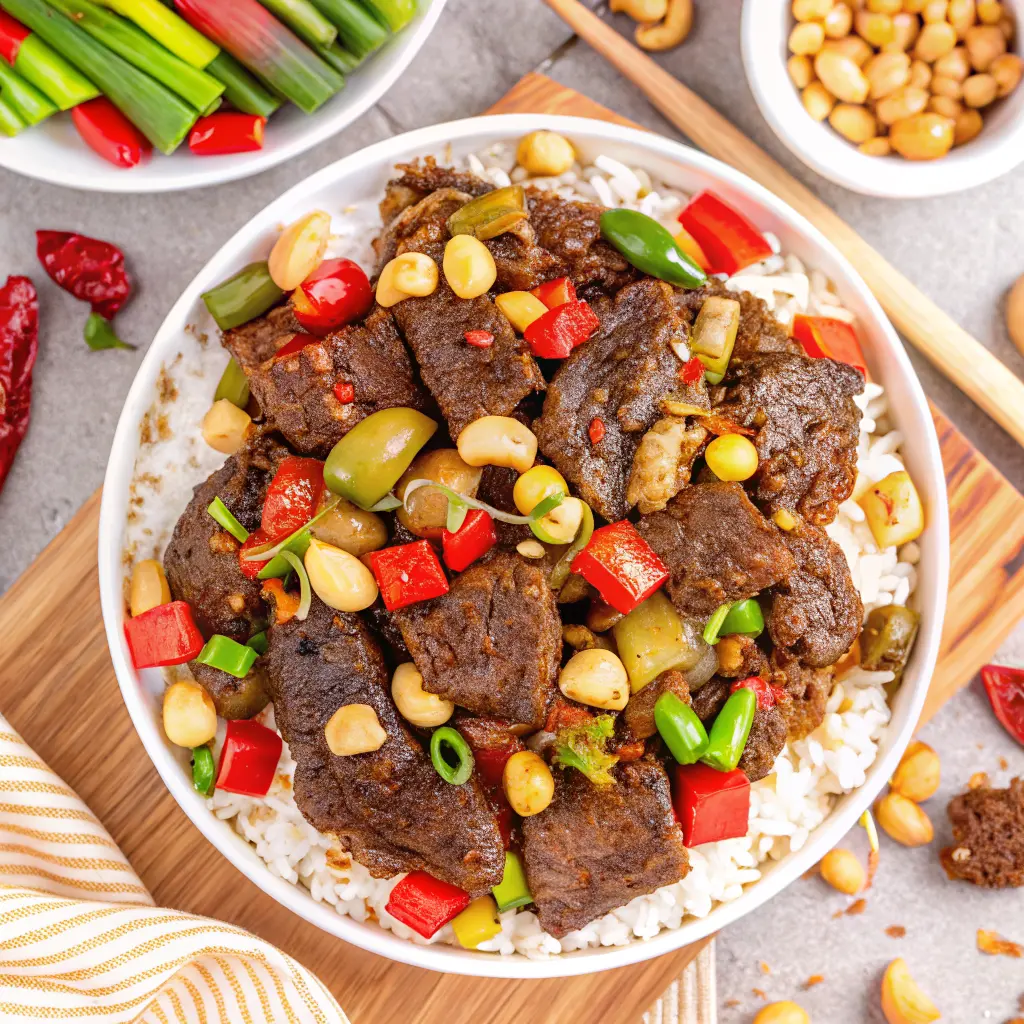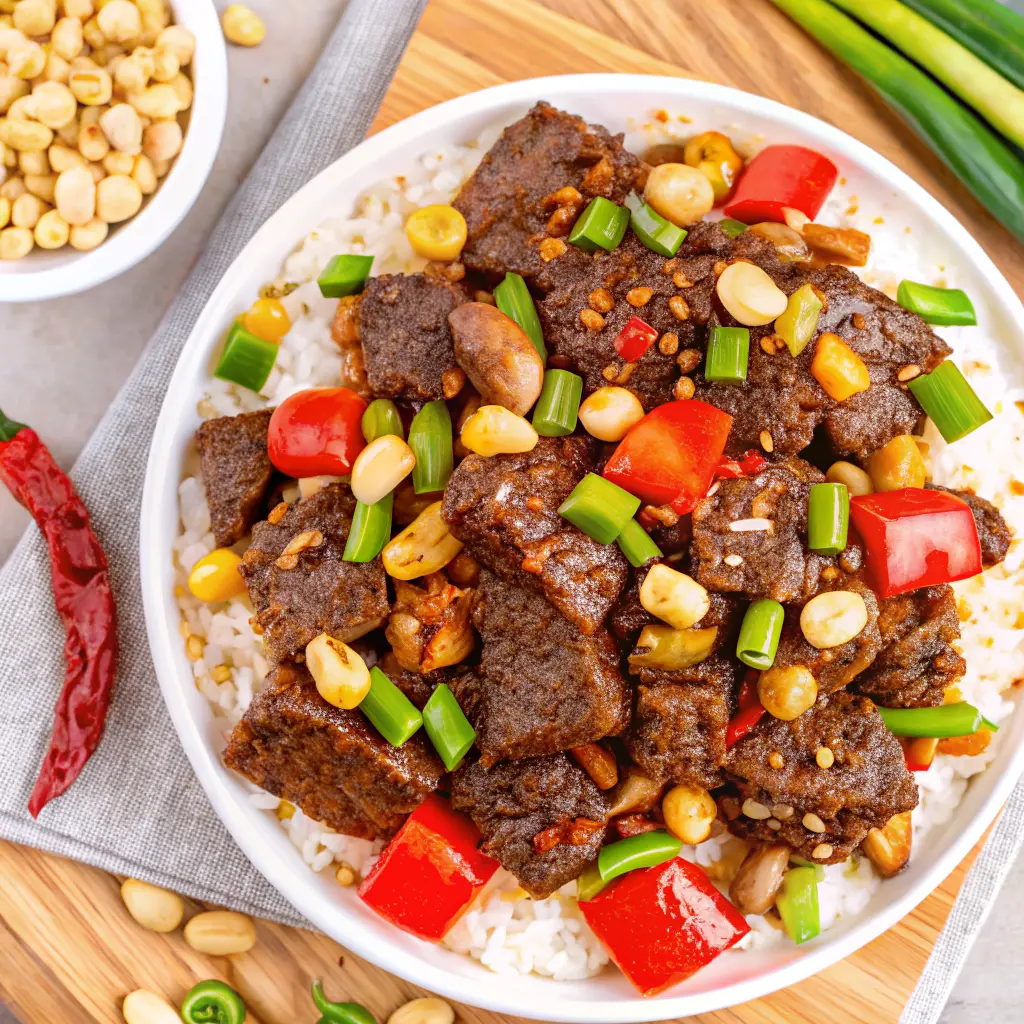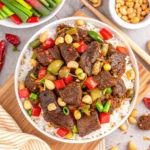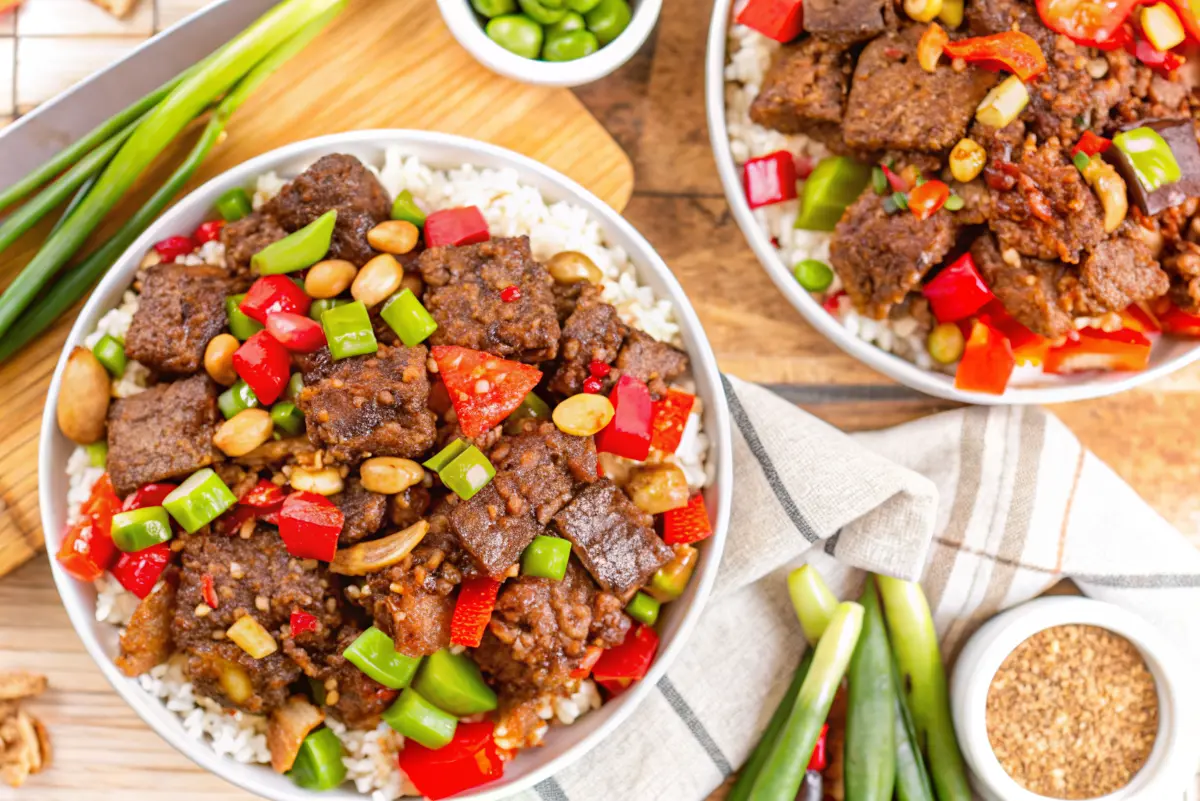Introduction
Kung Pao Beef is a vibrant, bold Chinese stir‑fry dish celebrated for its explosive blend of savory, spicy, tangy, and nutty flavors. Originating from Sichuan cuisine, it has become a favorite in Chinese restaurants worldwide, especially when served over jasmine rice or noodles. Whether you’re a cooking enthusiast or just curious, this dish promises a sensory adventure.
Roots & Cultural Legacy
The story behind Kung Pao Beef is intertwined with that of Kung Pao Chicken, which was named after Ding Baozhen, an 18th‑ to 19th‑century Qing dynasty official known by the title “Gong Bao” (palace protector). Though exact origins remain debated, legend holds that Ding loved a spicy stir‑fried dish with chicken, peanuts, and chilies—thus the dish took his name.
This adaptation still carries the signature Sichuan peppercorn numbing quality and deep, smoky chile fragrance typical of Sichuan cuisine. Sichuan cooking emphasizes heat layered with tang and a mouth‑tingling numbing effect—sometimes described as the “mala” sensation. The dish embodies this, along with the balance of salty, sweet, and sour flavors.
In Western Chinese restaurants, Kung Pao Beef became popular as a spicy beef option for diners wanting something beyond chicken or tofu. It remains a staple on menus: crisp beef strips, crunchy peanuts, dried chilies, and a rich, glossy sauce—delivered fast via high‑heat wok cooking.
Ingredient Breakdown: What Makes It Tick
Here’s a closer look at what makes Kung Pao Beef so irresistible:
- Beef: Typically flank steak (or skirt), sliced against the grain into thin, bite‑size strips for tenderness. Some recipes include velveting, coating with cornstarch (and optionally baking soda or Shaoxing wine) to achieve a silky texture (Diethood).
- Aromatics: Garlic, ginger, and the white parts of scallions contribute depth and fragrance.
- Dried chilies: Usually arbol or Chinese dried red chilies—whole or halved to control heat.
- Sichuan peppercorns: Ground or lightly crushed, these deliver the signature tingling numbing sensation.
- Bell peppers: Red or green, diced—add a fresh crunch and color contrast.
- Scallions (green parts): Added at the end for freshness.
- Peanuts: Roasted unsalted peanuts for a crunchy, savory finish.
- Sauce components:
- Soy sauce (often light or low-sodium)
- Rice vinegar or Chinese black vinegar
- Hoisin sauce for depth
- Brown sugar (or sugar) for sweet balance
- Cornstarch slurry to thicken
- Sesame oil for aroma
- Stock or water to help form a glossy, clingy coating.

Many cooks emphasize:
- High‑heat searing in a smoking‑hot wok for immediate caramelization.
- Batch cooking of beef to prevent overcrowding and ensure crisp edges.
- Stirring the sauce to dissolve cornstarch before adding, avoiding lumps.
Step‑by‑Step Cooking Method
Follow this detailed process to make authentic Kung Pao Beef:
1. Prep and Marinate
- Slice flank steak against the grain into ½‑cm strips.
- In a bowl, toss beef with:
- Cornstarch (about 2 tsp per 12 oz)
- Shaoxing wine or soy sauce
- A dash of oil and optional baking soda for tenderness
- Let sit for 10–60 minutes.
2. Mix the Sauce
In a separate bowl, whisk together:
- Soy sauce (¼ cup),
- Rice vinegar (or black vinegar),
- Hoisin sauce (1 Tbsp),
- Brown sugar (1 Tbsp),
- Sesame oil (½ tsp),
- Cornstarch slurry with water or stock,
- Sichuan peppercorn powder (½ tsp),
- A bit of stock or water to reach saucy consistency.
3. Roast Peanuts (Optional)
- Heat 1 Tbsp oil in wok, stir‑fry raw peanuts until golden and fragrant (~5 minutes).
- Remove and let cool—makes them extra crispy.
4. Sear the Beef
- Add 2 Tbsp oil to wok on full heat until smoking.
- Add marinated beef in a single layer; sear ~1–1.5 minutes per side until lightly browned.
- Remove and rest on plate.
5. Stir‑fry Aromatics and Veg
- With wok on medium-low, add ginger, dried chilies, and Sichuan peppercorns. Toast ~1 min until aromatic.
- Add bell peppers and white scallions; stir-fry ~1–2 mins until slightly tender.
- Add garlic; stir rapidly for ~20–30 seconds.
6. Combine Beef & Sauce
- Return beef to wok; increase heat to high.
- Stir sauce again then pour into wok.
- Stir constantly until sauce thickens and coats all ingredients (~1 min).
- Add roasted peanuts and green scallions; toss to combine.
7. Final Touches & Serving
- Taste and adjust seasoning (soy/sugar/vinegar).
- Serve immediately over steamed rice or noodles while still sizzling and vivid.
Cook’s Tips & Tricks
- Always prep all ingredients before cooking—the dish moves fast in the wok.
- If you want less heat, leave chilies whole or reduce number; if more heat, chop and include seeds.
- Ensure no overcrowding so beef sears, not stews.
- Avoid watery sauce by ensuring cornstarch is fully dissolved before adding.
- Use neutral high‑smoke‑point oil (like canola, peanut, or vegetable) for searing.

Flavor & Texture Magic
At its core, Kung Pao Beef thrives on contrast:
- Savory & tangy sauce: rich soy and hoisin balanced by vinegar and sugar.
- Spicy warmth: from whole or sliced dried chilies.
- Numbing zing: courtesy of Sichuan peppercorns.
- Tender beef: silky inside with lightly crisp exterior thanks to velveting and high‑heat searing.
- Crunchy bites: from peanuts and crisp‑tender veggies.
The visual appeal—a glossy dark reddish‑brown sauce enriched by colorful peppers and golden peanuts—also makes it irresistible on the plate.
Variations & Serving Suggestions
Variations to try:
- Protein swaps: thinly sliced chicken, shrimp, tofu, or ground beef in a one‑pan version. Ground beef variants cook faster and skip searing strips—ideal for weeknights.
- Vegetable swaps: green beans, snap peas, celery, or mushrooms for varied texture.
- Heat tweaks: adjust the amount/type of chilies and whether to include Sichuan peppercorns at all.
- Sauce twists: experiment with different vinegars or reduce hoisin for a simpler profile.
Serving ideas:
- Over steamed jasmine rice for traditional presentation.
- With noodles like chow mein or thick rice noodles for texture variation.
- Wrapped in lettuce cups, topped with scallions, cilantro.
- As part of a Chinese‑style dinner: pair with stir‑fried greens, dumplings, or fried rice.
Make‑ahead suggestions:
- Marinate beef in advance; mix sauce separately.
- Roast peanuts ahead and store—toss in at the end.
- Prep vegetables and aromatics before cooking to streamline the hot stir‑fry process.
Leftovers reheat well in a skillet: gently warm and stir to bring sauce back to coating consistency.
Frequently Asked Questions about Kung Pao Beef
1. What cut of beef is best for Kung Pao Beef?
The best cut is flank steak because it’s lean, flavorful, and becomes tender when sliced against the grain. Skirt steak or sirloin are also great alternatives.
2. Can I substitute chicken or tofu for Kung Pao Beef?
Yes! You can replace beef with chicken, tofu, shrimp, or even ground beef. The cooking technique remains the same—quick stir-frying on high heat.
3. What makes Kung Pao Beef different from Kung Pao Chicken?
The main difference is the protein. Kung Pao Beef has a richer, meatier flavor, while the chicken version is lighter. Both share the same spicy, savory sauce and peanuts.
4. Why does Kung Pao Beef have a numbing, spicy taste?
That famous tingling sensation comes from Sichuan peppercorns, which create the signature mala (numbing-spicy) flavor when combined with dried red chilies.
5. How spicy is Kung Pao Beef and can I adjust the heat?
It can be mild to very spicy. For less heat, use fewer chilies or leave them whole. For more spice, slice the chilies and add extra peppercorns or chili oil.
Conclusion
Kung Pao Beef is more than just a bold stir‑fry—it’s a harmonious celebration of flavor contrasts: the savory umami of soy and hoisin, the spicy warmth from chilies, the numbing zing of Sichuan peppercorns, the tender beef, crisp peanuts, and crunchy peppers. By following the step‑by‑step high‑heat method with proper marinating, sauce mixing, and ingredient prep, you can recreate this restaurant‑quality dish in your own kitchen.
Print
Best Kung Pao Beef Recipe – Spicy, Savory, and Irresistibly Delicious
- Total Time: 30 minutes
- Yield: 4 servings 1x
Description
This Kung Pao Beef is a Chinese-inspired stir-fry classic with a spicy, tangy sauce, tender beef strips, and crunchy peanuts. It’s quick, full of umami flavor, and perfect for a fast weeknight dinner that feels like restaurant takeout at home. Serve it over steamed rice or noodles for a complete meal!
Ingredients
For the beef:
- 1 lb flank steak or sirloin, thinly sliced
- 1 tbsp soy sauce
- 1 tbsp cornstarch
- 1 tbsp vegetable oil
For the sauce:
- 3 tbsp soy sauce
- 1 tbsp hoisin sauce
- 1 tbsp rice vinegar
- 1 tbsp brown sugar
- 2 tbsp water
- 1 tsp cornstarch
- 1/2 tsp sesame oil
For the stir-fry:
- 2 tbsp vegetable oil
- 2 cloves garlic, minced
- 1 tsp ginger, grated
- 6–8 dried red chilies (adjust for heat)
- 1 red bell pepper, chopped
- 1/2 cup roasted unsalted peanuts
- 2 green onions, sliced
Instructions
- Marinate the beef:
- Toss beef with soy sauce, cornstarch, and oil. Set aside for 10 minutes.
- Make the sauce:
- Whisk soy sauce, hoisin, rice vinegar, brown sugar, water, cornstarch, and sesame oil in a bowl.
- Cook the beef:
- Heat oil in a wok or skillet over high heat. Stir-fry beef until browned, about 3–4 minutes. Remove and set aside.
- Stir-fry aromatics & veggies:
- In the same pan, add more oil if needed. Sauté garlic, ginger, and dried chilies for 30 seconds. Add bell pepper and cook for 2 minutes.
- Combine everything:
- Return beef to the pan. Pour in the sauce and cook until thickened. Stir in peanuts and green onions.
- Serve:
- Serve hot over rice or noodles.
Notes
- Adjust spice level: Reduce dried chilies or use red pepper flakes for milder heat
- Protein swap: Use chicken, shrimp, or tofu instead of beef
- Crunch boost: Toast peanuts before adding for extra flavor
- Prep Time: 15 minutes
- Cook Time: 12 minutes
- Category: Mains
- Method: Stir-Fried
- Cuisine: Chinese
Nutrition
- Serving Size: 1 cup
- Calories: 340kcal
- Sugar: 6g
- Sodium: 780mg
- Fat: 18g
- Saturated Fat: 3g
- Trans Fat: 0g
- Carbohydrates: 16g
- Fiber: 2g
- Protein: 28g
- Cholesterol: 70mg

